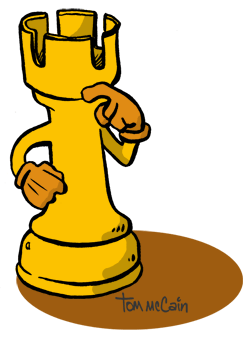 Creating a successful white paper isn’t just about the content. The content is in fact worthless if:
Creating a successful white paper isn’t just about the content. The content is in fact worthless if:
- The paper doesn’t support the brand,
- It’s too hard to read,
- Your credibility is lacking because the paper looks amateurish, and
- Your charts or graphics are boring.
I dare say most white papers are not tackling new theories or topics. And in a highly competitive situation, who are your prospects going to believe? The guy in the rumpled suit or the guy whose shirt is pressed, shoes polished and handshake firm? Likewise, a rumpled and amateurish white paper will not engender trust.
Here are five design guidelines for creating highly functioning and trustworthy white papers:
- Keep it readable:Readability is created by a combination of design tactics that take your specific content and audience into account.Choice of typeface is top on the list. While all computers have Arial available, a smarter choice for readability of long passages would be a face with a larger x-height. For example, for readability of lengthy white papers on screen, Verdana or Georgia are two excellent options. For readability on paper, Myriad Pro or Garamond may work well. Serif typefaces are usually more readable than sans serif, but you also have to weight that difference with your brand’s needs. Of course, there are thousands of typefaces available and your corporate brand style guide may also govern the ones you use.Bigger is not always better when it comes to sizing type. That said, there are many designers who adhere to the school of tiny type. Use a designer who understands the nuances of type size as it relates to your content, writing style, typeface selection and most importantly, the needs or your target demographic. Striking the right balance in size means ensuring readers can easily read your paper without squinting and that your type isn’t so large that they can’t see the forest for the trees.
Also consider line length and line spacing. Line lengths that are too short cause too much hyphenation and make reading a choppy venture. Lines that are too long make it difficult for the mind’s eye to track from the end of one line to the beginning of the next. To optimize reading speed, designers have for years been using the 66-72 characters per line rule. Generally speaking, this rule continues to work very well but again, is dependent on your white paper’s specific needs. Papers with lots of very long words may require a slightly longer line length. Just try reading a James Joyce novel with a short line length—painfully slow.
Line spacing also affects the ability of the mind’s eye to read quickly. Spacing that is too much or too little will slow the reader down, getting your message embedded later rather than sooner. Line spacing is also interdependent on typeface selection and average word length.
Keeping your white paper readable at maximum warp speed is a fine balance between many factors.
- Look professional: Good design will pre-sell your white paper and ultimately, you.Not realizing this and acting on it will place you in the league of second bests or the do-not-consider group. It’s really not any different than showing up at an interview in a freshly pressed suit, shoes polished, hair in place, teeth clean and nails trimmed.Likewise, if your white paper looks like it was created in Microsoft Word, it will compete poorly against a competitor’s paper that is branded, polished, neat and professional. There are many design nuances that Microsoft Word or Publisher lack but a good designer trained in traditional typographic techniques can provide.
- Be interesting: Being lively and interesting will get you more attention than the party bore.Don’t think that the term ‘white paper’ means you can’t use color or interesting graphics. White paper doesn’t refer to the overall design of your paper, and you’re doing your brand and your customer or prospect a disservice by not making your paper visually interesting.Now I don’t mean embellish your paper with fancy dingbats and doodads that don’t add value. Good design is not about decoration. Make sure all your graphics are working hard for the content and/or the brand image. And do something to stand out. Don’t be boring.
- Design for the distribution method:Good white papers will be shared digitally among peers.If your white paper is being distributed via email, be careful to adhere to the email marketing laws in the country of distribution, don’t use spam triggers, do apply permission-based marketing techniques and make it easy to share by including forward links.If your paper is a downloadable PDF, recipients are more likely to print it before reading. So make sure you design it to be most readable printed from an inkjet printer.
If you are professionally printing your paper for snail-mail distribution, you must also consider the paper stock used and ideally, make sure it is ballpoint or pencil ready with healthy margins for jotting notes.
- Pay attention to details: If God and the devil are both in the details, then this is where you’d better spend some time.We all know of HR people who throw away any resumes with typos, punctuation and grammar errors. It’s one way to narrow the field to the real professionals. Ditto with thought leadership and design. If you don’t look buttoned up in terms of details, how will prospects trust you with the details of their business?
In terms of white paper design details, look out for these common mistakes:
- Ditch those double spaces between sentences. It affects reading speed and isn’t necessary since we no longer use typewriters.
- Be consistent with periods and commas. If you’re using a serial comma, stick with it.
- Don’t break proper nouns at the end of a line, especially if the line length is long.
- Watch for too many hyphenations, which also slow reading and just look like you don’t care.
- Keep your bullets closer to their text than the line below them.
- Use a grid to align your content perfectly so nothing looks out of place.
- Consider balance of elements on a page. Look for triangulation of weight.
- Use styles to keep content consistently formatted.
- Use color appropriately and don’t overuse. This isn’t a flea market.
- Consider how your document will be printed and if on an office inkjet, make sure key content doesn’t exceed printer margins.
- Align table columns appropriately for the content. Align decimals on the decimal, for instance.
Skimpy Investments Deliver Skimpy Results.
Ultimately, good white paper design is about taking care of your prospects, making it easy for them to consider you. Yes, it’s a larger investment, but if that’s what gets you moved to the head of the pack, then that’s what you must do.
Remember, looking the part and being easy to understand shortens the distance to being considered a thought leader.
By Julia Moran Martz
 We all want the same thing as marketers: to establish our company as a trusted adviser, so when a prospect is ready to buy, he or she will think of us first. Part of this we accomplish through traditional marketing communications, but integrating thought-leadership content is also essential to reaching our goals.
We all want the same thing as marketers: to establish our company as a trusted adviser, so when a prospect is ready to buy, he or she will think of us first. Part of this we accomplish through traditional marketing communications, but integrating thought-leadership content is also essential to reaching our goals. Being known as an authoritative resource is powerful in today’s marketplace. The more recognition your company gets, the more powerful it becomes. With so much at stake, it pays not to make missteps in the thought leadership arena. Here’s how to get your strategy off on the right foot.
Being known as an authoritative resource is powerful in today’s marketplace. The more recognition your company gets, the more powerful it becomes. With so much at stake, it pays not to make missteps in the thought leadership arena. Here’s how to get your strategy off on the right foot.





